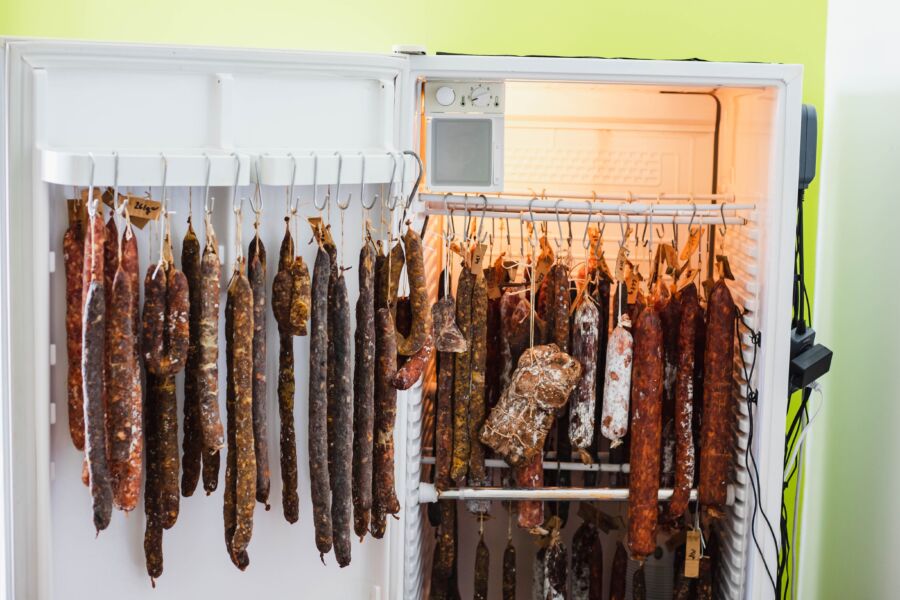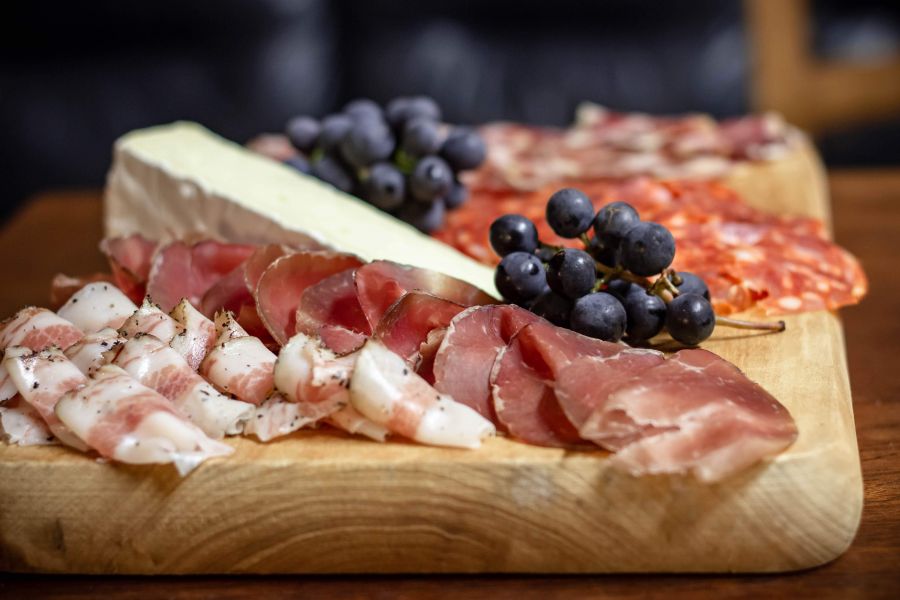Over the years, I’ve done a lot of meat curing using sodium nitrate and sodium nitrite, which is also known as pink-curing salt. A question that comes up a lot around here is whether you need to use them to make cured meats.
Curing meat also has a broad meaning, whether it’s dry cured or smoked/cooked (hot smoking). So, it’s dependent on the meat curing project as well.
Key Points:
- Natural alternatives like beetroot powder offer similar effects.
- Regulation mandates its use in commercial meat processing for risk management in countries.
- Concerns about carcinogen formation at high temperatures lead to its avoidance in certain applications.
- Depending on safety and preference, various cured meat processes may or may not involve pink curing salt.
I must have bought my first pink-curing salt 15 years ago, and it does last a long time. However, these days, I tend to use it less for certain projects.
My general answer to this question is as follows:
Not Using Pink Curing Salt (Sodium Nitrates and Nitrites) to cure meat is an option. It is used to lessen the risk of Botulism, speed up the curing process, and add a pink color. The application is a personal choice; if pink curing salt is not used, the other factors of meat curing need to be strictly adhered to.
Natural forms of pink-curing salt, like beetroot powder and celery powder, are now available. They have the same impact and are constructed the same way.
There are a few other names for pink-curing salt:
- Prague Powder
- Instacure
- Quick Cure
- Tinted Curing Mix

There are many other names around the global meat curing community, which I have been a part of for some time!
I cure most meat at home using some form of nitrate or nitrite at a 0.25% equilibrium cure.
That means 0.25% of the meat’s weight is 1000 grams to 2.5g of pink curing salt.
Due to many regulations across the Western world, it’s a must for any commercial producer of cured meats and other types of processed meat.
These regulations help the risk management perspective for commercial products.
Botulism is the reason why. You can find more about Botulism below.
I do not often use pink curing salt for whole-muscle meat curing or for making my dry-cured bacon. But I’ve also had nearly 2 decades of experience.
This is based on the research that pink curing salt has the potential, when cooked at high heat, over 350°F or 180°C, to turn into nitrosamines and could form carcinogens. Carcinogens are associated with the risk of cancer.
So, it will be without pink curing salt when I want something crispy or cooked over 180°C/350 F.
Curing Meat Without Sodium Nitrate/Nitrite
My main concern is adding nitrites and nitrates to cured meats and cooking them over 350°F/180°C, as mentioned.
So, I do not add them to my dry, cured, cold, smoked bacon since I like my bacon crispy!
If I’m cooking Italian with dry-cured pancetta, which is pork belly that’s been dry salt-cured and then dried out to either be eaten or cooked with, I don’t use pink curing salts. Spaghetti carbonara is traditionally made with pancetta, which is fried.
I’ve been making a cold-smoked type of Hungarian dry-cured salami for three sessions over three days.
It’s an odd product because it has just enough salt to cure. It is fried up like a fresh sausage (around the 1.8-2% total salt equilibrium cured).

Traditionally, this is a cold-smoked salami/sausage that is cooked, and because of this, I don’t use pink curing salt. These are sheep casing diameter-type salamis, so they only take 4 to 6 weeks to dry out (they are thin).
For long-term dry-cured salami (many meats can be used for salami) that takes 3 to 6 months, I have been using pink curing salt no. 2 for experiments with and without it. I feel my technique is refined enough now to not have any risk issues around botulism with this.
What Does Pink Curing Salt Do to Meat?
The main reason why pink curing salt is used is that it inhibits and reduces the chance of botulism.
It also tends to produce a pinkish color in cooked or smoked meat. This is why the dry-cured smoked bacon you buy in supermarkets is always pink, and without the presence of sodium nitrite, it would possibly be greyish.
Grey is not a marketable color for meat, like grey deli ham! (Note! Some salts carry some form of natural nitrate; they could create the pink color, too.)
I can’t say this is true – but some believe pink curing salt creates a more porky flavor.
The Definition of Curing & How it Relates
Curing uses salt to bind water and diffuse it, whether using a dry salt curing mix or a wet brine curing mix.
Pink curing salt is generally 90% salt; the remaining amount of no. 1 or no. 2 is sodium nitrate and sodium nitrite. If you want to read more about these different types of pink curing salts, here is a link I wrote.
What are Nitrates or Nitrites?
A quick summary about it.
Pink curing salt no. 1 is generally used for meat curing projects that take less than 30 days. It only contains sodium nitrite and salt.
Pink curing salt no. 2 is used for over 30 days of meat curing, most commonly whole muscle dry-cured long-term projects and dry-cured salami. This will take 2 months up to 8 months or years to develop (5 years for Jamon/ Iberian Ham!)
No. 2 has nitrates and nitrites, and I believe that within a few months, the nitrates break down into nitrites.
Where Are Nitrates Naturally Found?
80% of the nitrates we consume as humans are from vegetables. 5% in Europe is from cured meats. They do quite a lot of cured meats too!
Supposedly, nitrates occur naturally in our bodies and in the soil.
The heat and reaction seem to create issues, but moderation is also important.
Different Types of Meat Curing Using Nitrates/Nitrites
Dry Curing or Wet Curing and then Cooking and Smoking
On my blog (eatcuredmeat.com) I categorize cured meat as hot smoking, which is a simple cure for meat I plan to smoke/cook – like fish, I catch.
I cook and smoke wild turkey meat or pastrami at around 200°F or 100°C.
Examples of Hot Smoked Products
- Pastrami
- Deli Ham, Ham on the Bone, or Off the Bone
- Snack Sticks
Warm-smoked products are another category that many are not familiar with. In Europe, the meat is smoked in winter temperatures around 0°C or 30°F.
I realize that meat at this temperature (90-140°F/30-60°C) is called the danger zone.
What sometimes doesn’t get taken into account is whether the meat has been salt-cured or wet brine-cured. At these temperatures, this will significantly impact inhibiting or slowing bacterial growth, depending on the amount of salt.
Warm Smoked Products
- Eastern European Sausages / Salamis
- Certain Hams
Dry Curing Only without Cooking
My method involves dry-curing meat with salt and spices to create some of the Italian classics or Spanish styles.
Dry Cured Products
- Dry Cured Whole Muscle -Prosciutto, Braesola, Pancetta
- Dry Cured Salami – Soppresatta, Picante, Genoa,

Curing, then Cooking/Smoking, then Cooking Again
- Hot Smoked Bacon
- Deli Ham
This is a personal preference. People may cure meat (I created a calculator for equilibrium curing here) without pink curing salt or cure bacon and hot smoke to a safe internal temperature.
Then, they often freeze it up and cook it again to make it crispy. This is an area where it’s better without nitrites.
Research on Botulism Cases in Relation
In the 2017 Statistics On Botulism in America, 19 cases were reported.
Here is how each one happened:
Food-borne botulism cases were reported from California (n=15) and Alaska (n=4). Among the 15 toxin type A food-borne botulism cases in California: 10 were from an outbreak linked to nacho cheese at a convenience store, two were from an outbreak linked to an herbal deer antler tea, one was from a suspected soup with bulging lid (no testing), and two were not linked to a known food source. (Table1) Among the four toxin type E food-borne botulism cases in Alaska: 3 were from an outbreak linked to seal blubber with seal oil, and one was linked to dried herring in seal oil (Table 2a). The median age of patients was 42 years (range: 14–85 years); 11 were men. 3 deaths were reported
Centers for Disease Control & Prevention https://www.cdc.gov/botulism/about/index.html#:~:text=Botulism%20(%22BOT%2Dchoo%2D,Clostridium%20baratii%20bacteria%20(germs).
Looking back at 2017-2014, the statistics of the Centers for Disease Control and Prevention show there are 100 to 200 botulism cases per year botulism cases in the United States. But if you read through the descriptions, Canning comes up with the odd time for food-borne botulism.
You will notice that it’s main issues around the traditional indigenous preparation of seal meat that take most of the statistics for food-borne botulism.
Dried fish came up once when I read back through some years, but I don’t know if this is related to adding any salt, dry curing, and brining.
Amount of Nitrates & Nitrites Consumed
The key is always moderation. Most of us like convenient food with processed goodness from the deli. It’s a pity that so much food worldwide is full of additives, preservatives, and nitrites.
Moderating the intake is one aspect. In my opinion, it is obvious there is no passion or care instilled in making cheap, convenient food, but it’s part of feeding the masses!

Tom Mueller
For decades, immersed in studying, working, learning, and teaching the craft of meat curing, sharing the passion and showcasing the world of charcuterie and smoked meat. Read More
